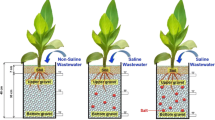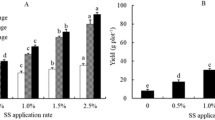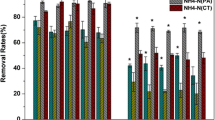Abstract
To identify the effect of influent salinity on substrate selection, a study was conducted in pilot-scale surface flow constructed wetlands (SFCWs). Compared with gravel and sand SFCWs, soil SFCWs performed similarly or worse at low salinities, while at high salinities, soil SFCWs performed similarly or better in removal efficiency (RE) of salt, total nitrogen (TN), total phosphorous (TP), and chemical oxygen demand (COD). Soil generally increased macrophyte growth (especially at high salinity) in terms of biomass, leaf chlorophyll concentration, root activity, and root catalase and superoxide dismutase activities. A general decrease in bacterial α-diversity in the rhizosphere was observed at high salinity, while compared with gravel or sand, soil improved rhizosphere bacterial community stability at varying salinities. At high salinity, compared with that of gravel or sand, the soil support of macrophytes and rhizosphere microorganisms increased pollutant RE in SFCWs. This finding highlights the necessity of varying substrate selection in SFCWs with influent salinities for both increasing pollutant RE and reducing input cost, with soil recommended at high influent salinity.






Similar content being viewed by others

References
Ahkami AH, Allen White R, Handakumbura PP, Jansson C (2017) Rhizosphere engineering: enhancing sustainable plant ecosystem productivity. Rhizosphere 3:233–243
Bai B, Jin J, Bai S, Huang L (1994) Improved method for determination of TTC in maize root system. Corn Sci 2:44–47
Berendsen RL, Pieterse CMJ, Bakker PAHM (2012) The rhizosphere microbiome and plant health. Trends Plant Sci 17:478–486
Bo Y, Yu l, Chen T, Fan P, Jin K (2015) Biofilm formation and start-up of denitrification subsurface constructed wetland. Chin Wat Wastewat 31:10–13
Du J, Li Q, Zhao R, Yang J, Zhou S, Chen C, Zhang M, Zhao D, An S (2021) Effect of influent salinity on the selection of macrophyte species in floating constructed wetlands. J Environ Manag 282:111947
Gao F, Liu G, She Z, Ji J, Gao M, Zhao Y, Guo L, Jin C (2021) Effects of salinity on pollutant removal and bacterial community in a partially saturated vertical flow constructed wetland. Bioresour Technol 329:124890
Iamchaturapatr J, Yi SW, Rhee JS (2007) Nutrient removals by 21 aquatic plants for vertical free surface-flow (VFS) constructed wetland. Ecol Eng 29:287–293
Jiang J, Zhou C, An S, Yang H, Guan B, Cai Y (2008) Sediment type, population density and their combined effect greatly charge the short-time growth of two common submerged macrophytes. Ecol Eng 34:79–90
Klomjek P, Nitisoravut S (2005) Constructed treatment wetland: a study of eight plant species under saline conditions. Chemosphere 58:585–593
Li ZQ, Kong LY, Yang LF, Zhang M, Cao T, Xu J, Wang ZX, Lei Y (2012) Effect of substrate grain size on the growth and morphology of the submersed macrophyte Vallisneria natans L. Limnologica 42:81–85
Li H, Chi Z, Li J, Wu H, Yan B (2019a) Bacterial community structure and function in soils from tidal freshwater wetlands in a Chinese delta: potential impacts of salinity and nutrient. Sci Total Environ 696:134029
Li W, Zheng T, Ma Y, Liu J (2019b) Current status and future prospects of sewer biofilms: their structure, influencing factors, and substance transformations. Sci Total Environ 695:133815
Li X, Li Y, Lv D, Li Y, Wu J (2020) Nitrogen and phosphorus removal performance and bacterial communities in a multi-stage surface flow constructed wetland treating rural domestic sewage. Sci Total Environ 709:136235
Liang Y, Zhu H, Bañuelos G, Yan B, Zhou Q, Yu X, Cheng X (2017) Constructed wetlands for saline wastewater treatment: a review. Ecol Eng 98:275–285
Lu J, Peng H (2012) Research progress in resistance of plants in Iris. Acta Agr Jiangxi 24:48–51
MacTavish RM, Cohen RA (2017) Water column ammonium concentration and salinity influence nitrogen uptake and growth of Spartina alterniflora. J Exp Mar Biol Ecol 488:52–59
Marschner P, Yang CH, Lieberei R, Crowley DE (2001) Soil and plant specific effects on bacterial community composition in the rhizosphere. Soil Biol Biochem 33:1437–1445
Mateus DMR, Pinho HJO (2020) Evaluation of solid waste stratified mixtures as constructed wetland fillers under different operation modes. J Clean Prod 253:119986
Qin K, Dong X, Jifon J, Leskovar DI (2019) Rhizosphere microbial biomass is affected by soil type, organic and water inputs in a bell pepper system. Appl Soil Ecol 138:80–87
Radhakrishnan R, Baek KH (2017) Physiological and biochemical perspectives of non-salt tolerant plants during bacterial interaction against soil salinity. Plant Physiol Biochem 116:116–126
Ramond J-B, Welz PJ, Cowan DA, Burton SG (2012) Microbial community structure stability, a key parameter in monitoring the development of constructed wetland mesocosms during start-up. Res Microbiol 163:28–35
Romero-Oliva CS, Contardo-Jara V, Pflugmacher S (2015) Antioxidative response of the three macrophytes Ceratophyllum demersum, Egeria densa, and Hydrilla verticillata to a time dependent exposure of cell-free crude extracts containing three microcystins from cyanobacterial blooms of Lake Amatitlán. Guatemala Aquat Toxicol 163:130–139
Sheng Q, Wang L, Wu J (2015) Vegetation alters the effects of salinity on greenhouse gas emissions and carbon sequestration in a newly created wetland. Ecol Eng 84:542–550
Singh VK, Singh AK, Singh PP, Kumar A (2018) Interaction of plant growth promoting bacteria with tomato under abiotic stress: a review. Agric Ecosyst Environ 267:129–140
Stefanakis AI (2020) Constructed wetlands for sustainable wastewater treatment in hot and arid climates: opportunities, challenges and case studies in the Middle East. Water 12:1665
Sun H, Xu S, Wu S, Wang R, Zhuang G, Bai Z, Deng Y, Zhuang X (2019) Enhancement of facultative anaerobic denitrifying communities by oxygen release from roots of the macrophyte in constructed wetlands. J Environ Manag 246:157–163
Vergani L, Mapelli F, Zanardini E, Terzaghi E, Di Guardo A, Morosini C, Raspa G, Borin S (2017) Phyto-rhizoremediation of polychlorinated biphenyl contaminated soils: an outlook on plant-microbe beneficial interactions. Sci Total Environ 575:1395–1406
Wang X, Huang J (2014) Principles and techniques of plant physiological and biochemical experiments. Higher Education Press, Peking, pp 282–287 (in Chinese)
Wang J, Wang S (2019) Preparation, modification and environmental application of biochar: A review. J Clean Prod 227:1002–1022
Wang C, Liu Z, Zhang Y, Liu B, Zhou Q, Zeng L, He F, Wu Z (2018) Synergistic removal effect of P in sediment of all fractions by combining the modified bentonite granules and submerged macrophyte. Sci Total Environ 626:458–467
Wang Q, Ma L, Zhou Q, Chen B, Zhang X, Wu Y, Pan F, Huang L, Yang X, Feng Y (2019) Inoculation of plant growth promoting bacteria from hyperaccumulator facilitated non-host root development and provided promising agents for elevated phytoremediation efficiency. Chemosphere 234:769–776
Wang X, Zhu H, Yan B, Shutes B, Bañuelos G, Wen H (2020a) Bioaugmented constructed wetlands for denitrification of saline wastewater: a boost for both microorganisms and plants. Environ Int 138:105628
Wang Y, Cai Z, Sheng S, Pan F, Chen F, Fu J (2020b) Comprehensive evaluation of substrate materials for contaminants removal in constructed wetlands. Sci Total Environ 701:134736
Xu Y, Wang G, Jin J, Liu J, Zhang Q, Liu X (2009) Bacterial communities in soybean rhizosphere in response to soil type, soybean genotype, and their growth stage. Soil Biol Biochem 41:919–925
Yan J, Jiang T, Yao Y, Wang J, Cai Y, Green NW, Wei S (2017) Underestimation of phosphorus fraction change in the supernatant after phosphorus adsorption onto iron oxides and iron oxide–natural organic matter complexes. J Environ Sci 55:197–205
Yang Y, Zhao Y, Liu R, Morgan D (2018) Global development of various emerged substrates utilized in constructed wetlands. Bioresour Technol 261:441–452
Zhai W, Ding J, An X, Wang Z (2020) An optimization model of sand and gravel mining quantity considering healthy ecosystem in Yangtze River. China J Clean Prod 242:118385
Zhao D, Lv L, Liu Z, Zhang M, An S (2018a) The carbon source function of constructed wetland macrophytes and its improvement strategy. Acta Ecol Sin 38:5961–5969
Zhao D, Zhang M, Liu Z, Sheng J, An S (2018b) Can cold-season macrophytes at the senescence stage improve nitrogen removal in integrated constructed wetland systems treating low carbon/nitrogen effluent? Bioresour Technol 265:380–386
Zhao D, Chen C, Lu Q, Zhang M, Zhang H, An S (2020) Combined use of cold-season and warm-season macrophytes in floating constructed wetlands to increase nitrogen removal in the early cold season. J Clean Prod 254:120054
Zheng Y, Wang X, Xiong J, Liu Y, Zhao Y (2014) Hybrid constructed wetlands for highly polluted river water treatment and comparison of surface- and subsurface-flow cells. J Environ Sci 26:749–756
Zheng Y, Wang X, Dzakpasu M, Zhao Y, Ngo HH, Guo W, Ge Y, Xiong J (2016) Effects of interspecific competition on the growth of macrophytes and nutrient removal in constructed wetlands: a comparative assessment of free water surface and horizontal subsurface flow systems. Bioresour Technol 207:134–141
Availability of data and materials
The data sets supporting the results of this article are included within the article and its additional files.
Funding
The financial support was provided by the Major Science and Technology Program for Water Pollution Control and Treatment, China (No. 2017ZX07602-002) and the Water Resources Science and Technology Project of Jiangsu Province, China (2018064).
Author information
Authors and Affiliations
Contributions
Shenyan Zhou: methodology, validation, data curation, investigation, writing—original draft, and resources. Ran Zhao: validation and investigation. Qiming Li: validation and investigation. Juan Du: validation, data curation, and investigation. Chen Chen: investigation and resources. Qianqian Lu: resources and investigation. Miao Zhang: data curation, investigation, and resources. Dehua Zhao: conceptualization, data curation, writing—review/editing, and supervision. Shuqing An: writing—review/editing and funding acquisition.
Corresponding author
Ethics declarations
Ethics approval and consent to participate
Not applicable
Consent for publication
Written informed consent for publication was obtained from all participants.
Competing interests
The authors declare no competing interests.
Additional information
Responsible Editor: Alexandros Stefanakis
Publisher’s note
Springer Nature remains neutral with regard to jurisdictional claims in published maps and institutional affiliations.
Supplementary Information
ESM 1
(DOCX 3150 kb)
Rights and permissions
About this article
Cite this article
Zhou, S., Zhao, R., Li, Q. et al. Influent salinity affects substrate selection in surface flow constructed wetlands. Environ Sci Pollut Res 28, 62235–62245 (2021). https://doi.org/10.1007/s11356-021-15036-5
Received:
Accepted:
Published:
Issue Date:
DOI: https://doi.org/10.1007/s11356-021-15036-5



